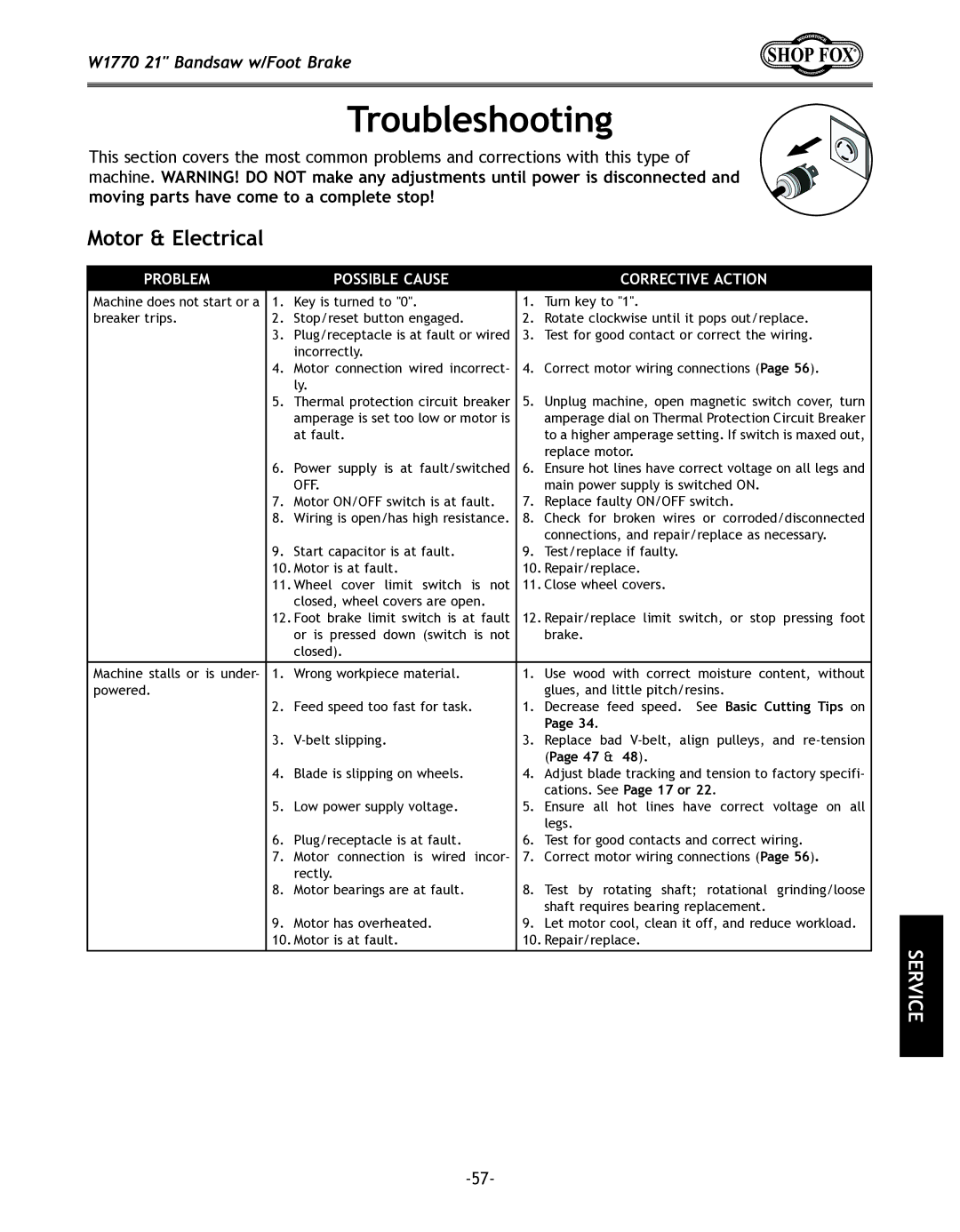
W1770 21" Bandsaw w/Foot Brake
Troubleshooting
This section covers the most common problems and corrections with this type of machine. WARNING! DO NOT make any adjustments until power is disconnected and moving parts have come to a complete stop!
Motor & Electrical
PROBLEM |
| POSSIBLE CAUSE |
| corrective action |
Machine does not start or a | 1. | Key is turned to "0". | 1. | Turn key to "1". |
breaker trips. | 2. | Stop/reset button engaged. | 2. | Rotate clockwise until it pops out/replace. |
| 3. | Plug/receptacle is at fault or wired | 3. | Test for good contact or correct the wiring. |
|
| incorrectly. |
|
|
4.Motor connection wired incorrect- 4. Correct motor wiring connections (Page 56). ly.
5.Thermal protection circuit breaker 5. Unplug machine, open magnetic switch cover, turn
| amperage is set too low or motor is |
| amperage dial on Thermal Protection Circuit Breaker |
| at fault. |
| to a higher amperage setting. If switch is maxed out, |
|
|
| replace motor. |
6. | Power supply is at fault/switched | 6. | Ensure hot lines have correct voltage on all legs and |
| OFF. |
| main power supply is switched ON. |
7. | Motor ON/OFF switch is at fault. | 7. | Replace faulty ON/OFF switch. |
8.Wiring is open/has high resistance. 8. Check for broken wires or corroded/disconnected connections, and repair/replace as necessary.
9. Start capacitor is at fault. | 9. Test/replace if faulty. |
10. Motor is at fault. | 10. Repair/replace. |
11.Wheel cover limit switch is not 11. Close wheel covers. closed, wheel covers are open.
12. Foot brake limit switch is at fault | 12. Repair/replace limit switch, or stop pressing foot | |||
| or is pressed down (switch is not |
| brake. |
|
| closed). |
|
|
|
|
|
|
| |
Machine stalls or is under- 1. | Wrong workpiece material. | 1. | Use wood with correct moisture content, without | |
powered. |
|
| glues, and little pitch/resins. | |
2. | Feed speed too fast for task. | 1. | Decrease feed speed. See Basic Cutting Tips on | |
|
|
| Page 34. |
|
3. | 3. | Replace bad | ||
|
|
| (Page 47 & | 48). |
4. | Blade is slipping on wheels. | 4. | Adjust blade tracking and tension to factory specifi- | |
|
|
| cations. See Page 17 or 22. | |
5. | Low power supply voltage. | 5. | Ensure all hot lines have correct voltage on all | |
|
|
| legs. |
|
6. | Plug/receptacle is at fault. | 6. | Test for good contacts and correct wiring. | |
7. | Motor connection is wired incor- | 7. | Correct motor wiring connections (Page 56). | |
| rectly. |
|
|
|
8. | Motor bearings are at fault. | 8. | Test by rotating shaft; rotational grinding/loose | |
|
|
| shaft requires bearing replacement. | |
9. | Motor has overheated. | 9. | Let motor cool, clean it off, and reduce workload. | |
10. Motor is at fault. | 10. Repair/replace. | |||
SERVICE
